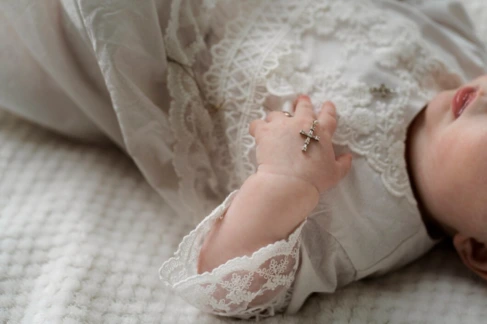
A christening gown is a cherished keepsake, often passed down through generations. However, over time, these delicate garments can become yellowed or stained due to improper storage, exposure to air, and natural fabric aging. The good news is that restoring a christening gown to its original beauty is possible with the right techniques.
Why Do Christening Dresses Yellow Over Time?
Yellowing and staining occur due to various factors, including:
Understanding these causes helps in selecting the right restoration and preservation method to maintain the beauty of a christening gown.
How to Restore a Yellowed Christening Dress
Instead of attempting DIY techniques that could damage delicate fabrics, investing in a professional christening dress preservation kit is often the safest option.
1. Professional Christening Gown Preservation
A professional preservation service can effectively remove visible and invisible stains using advanced cleaning methods. Specialized fabric cleaning technologies ensure that the integrity of delicate fabrics is maintained while removing discoloration and preventing further damage. These methods include solvent-based cleaning techniques that penetrate deep into the fibers, dissolving stains that may have set over time.
2. The Role of a Preservation Kit
A christening gown preservation kit is specifically designed to clean and protect garments for long-term storage. These kits often include acid-free preservation chests, stain removal treatments, and protective packaging to prevent yellowing. Unlike DIY handwashing, which can cause shrinkage or fabric distortion, a professional kit ensures the gown is treated with care.
3. Proper Storage Methods
Once cleaned, storing the gown in an acid-free preservation chest with a viewing window can help protect it from air pollutants, moisture, and insects. This method prevents future discoloration and allows for safe long-term storage. The use of acid-free tissue paper between fabric layers further safeguards the gown from creasing and fabric breakdown.
The Christening Gown Preservation Process
Restoring and preserving a gown professionally typically involves several key steps:
Step 1: Assessment and Cleaning
The gown is carefully inspected for stains and fabric wear. Advanced fabric cleaning technology, such as SYSTEMK4, is used to remove discoloration while maintaining fabric integrity. This specialized cleaning process is designed for delicate materials and ensures the safe removal of even invisible stains.
Step 2: Protective Storage
After cleaning, the gown is placed in an acid-free preservation chest. This protects it from environmental damage and ensures longevity. The preservation chest provides a sealed environment to prevent oxidation, one of the main causes of yellowing.
Step 3: Long-Term Care
Properly stored gowns can be passed down through generations. Periodically checking the preservation chest ensures the fabric remains in good condition. If stored correctly, a christening gown can remain pristine for over a century.
Best Practices for Preventing Yellowing
To extend the life of a christening gown and prevent future discoloration, follow these essential care tips:
Can Any Christening Dress Be Restored?
While many gowns can be successfully restored, some may have irreversible damage depending on their age and previous storage conditions. Gowns that are heavily deteriorated or have extensive mold damage may require expert evaluation to determine the best restoration approach. In general, gowns less than 20 years old respond exceptionally well to professional cleaning and preservation methods.
Final Thoughts
Restoring and preserving a christening gown requires careful attention to fabric care and storage techniques. Professional preservation services can effectively remove stains and prevent yellowing, ensuring that these cherished garments remain in pristine condition for future generations.
Proper storage and maintenance can help maintain the gown’s beauty and historical significance for years to come. Investing in professional preservation is the best way to keep this heirloom piece safe, allowing it to be passed down as a treasured family keepsake.

































